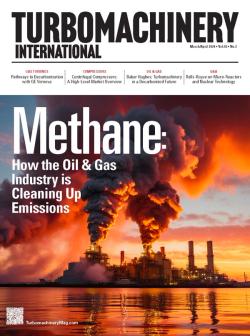
OR WAIT null SECS
© 2024 MJH Life Sciences™ and Turbomachinery Magazine. All rights reserved.
MYTH BUSTERS: DEVELOPMENT PATHS FOR NEXT-GENERATION POWER PLANTS (Part 2)
S everal recent publications suggested that the use of compressor inter-stage cooling, inter-stage turbine reheat, pressure gain combustion and, consequently, segregated process components interconnected with piping would be a practical path forward to improve combined cycle power plant (CCPP) performance. These options require a paradigm shift away from increased firing temperatures with incremental improvements in performance.
One argument is that we have reached diminishing returns with firing temperatures and must look at more advanced or more complex cycles. Although attractive from a thermodynamic cycle and design perspective, this is not always practical because of economics.
If the key elements of the cycle are separated rather than integral, one may as well look at closed hybrid Brayton and Rankine cycle configurations, as well as using better thermodynamic fluids, such as supercritical CO2 (sCO2) or organic fluids. The challenges then become heat addition, either direct-fired using oxy-combustors, or indirect heated with large heat exchangers, as well as wet or dry heat rejection cooling.
De-emphasizing firing temperature as the only approach to improved cycle efficiency makes sense. The curse of Carnot will not go away (the law that limits the best achievable efficiency of any closed-system heat engine, based on heat source and sink temperature ratio). So other technologies to improve efficiency should be explored.
A strong thermodynamic case can be made for pressure-gain combustion and multiple stages of re-heat in the hot gas path of a Brayton cycle. Isothermal or near-isothermal compression and expansion processes are inherently more efficient than isentropic processes.
An increase in pressure during the combustion process provides added pressure for higher energy recovery in the hot section. But practical implementation requires a different design approach.
Rather than a single integrated and compact lightweight module, the power plant would consist of individually segmented process components (compressors, heaters, turbines) that are interconnected with piping and ducting.
Although this sounds reasonable, it is unlikely that manufacturers would pursue it in the near term for a marginal efficiency gain (up to 3%). They will not invest billions in drastic design and operational philosophy changes. For the simple-cycle GT, they are likely to continue an evolutionary development path, pushing firing temperature and pressure ratio upward.
The segmented approach also neglects alternative topping and bottoming cycles beyond a brute force firing temperature increase. But many of these novel cycles are not air-based and require different process fluids.
Examples are organic Rankine cycles for low-temperature bottoming cycles, sCO2 closed cycles for medium-temperature bottoming cycles, and CO2-based direct and indirect fired oxy-fuel cycles for steam-based topping cycle replacements.
Although inexpensive, air, water and steam are not ideal working fluids. Thus alternative process fluids must be explored. Current research is even looking at the concept of blending gases (or spiking carbon dioxide with hydrocarbons) to optimize the process fluid’s critical phase point for a given heat source and heat sink temperature.
All of these cycles are closed loops and require some development in heat-input, heat-rejection and heat recuperation (as well as novel turbomachinery). Promising developments include micro-channel and micro-tube heat exchangers and direct-fired oxy-fuel combustors.
Scientific adventures?
Importantly, the pressure and temperature ranges (<300 bar and <1,300°C, respectively) are well within material limits. Process equipment design challenges are engineering tasks rather than scientific adventures.
For example, over the last 10 years, R&D in sCO2 plants for waste heat recovery (WHR) applications has led to various options for bottoming cycles that reach nearly 40% efficiency for H-class exhaust conditions.
This gain alone would make a CCPP exceed 65% efficiency if a steam and a secondary bottoming cycle are used. Although these plants have not been demonstrated, there are no impossible technology gaps.
Multi-stage re-heat GTs, isothermal compression, pressure gain combustion, and segmented process plant design will be pursued as technology options. But lower cost alternatives are either available or currently being pursued.
They focus on improving the process fluid and closed power cycles rather than making the heat engine cycle more complicated. The development of sCO2 cycles is one example.
The two most fundamental options for improved CCPP efficiency are: Raising firing temperature and pressure ratio, or using segmented process plants with multiple stages of WHR, inter-stage heating and cooling, separated process machinery within closed-cycles, advanced process fluids and pressure-gain combustion.
On a more fundamental level: Is a small gain in efficiency worth it when it could lead to higher NOx and CO emissions, cost increases, lower reliability and a limited operating range? If carbon capture becomes mandatory, the picture drastically changes since basic efficiency and electricity price would not be primary drivers.
Maybe the answer is not faster and hotter but smarter. It may be that our shifting energy mix will require GT plants to complement renewables. The capability of GT plants to start fast, and operate efficiently at part load may become more important than high full-load efficiency.
Maintaining initial performance over time through system integration, and advanced predictive maintenance procedures might be additional key requirements.


